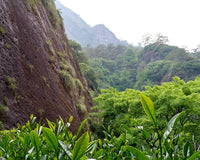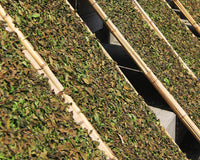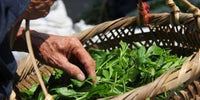An Introduction To Gaiwan
The Gaiwan is a traditional tea ware used widely throughout China. There are two ways in which it is used. Firstly, it serves as a lidded tea cup in which the tea is brewed, and from which the tea is drunk. Secondly, it is a vessel used only for brewing the tea and the liquor is then poured into a secondary cup to drink, or into a jug for sharing.
A Chinese Gaiwan consists of a bowl with a lid, which sits on a saucer. The lid is domed and has an insulated knob so that it can easily be lifted off or used to strain the liquor from the leaves.
"Tea tempers the spirits and harmonises the mind, dispels lassitude and relieves fatigue, awakens thought and prevents drowsiness..."
Lu Yu, The Classic of Tea: Origins and Rituals

Gaiwan Uses
It is more common to use the Gaiwan as both the brewing and drinking vessel (method 1) in the north of China. On the news, you can often observe this technique in use during news footage of government meetings in Beijing. This method particularly suits green and jasmine teas, but is also commonly used for drinking flower tisanes like chrysanthemum.
Method one favours a larger Gaiwan which is often highly decorated. These larger gaiwans range from the mass-produced variety with digitally-printed designs, to handmade gaiwans which are hand-painted by skilled artisans in the renowned porcelain town of Jing De Zhen (景德镇), Jiangxi province. These gaiwans are lifted on the saucer to drink, so the saucer is broader to make it easier to hold. The saucer also has a deeper recess to ensure the cup doesn't move or slip.
Using the Gaiwan as a 'teapot' (method 2) has become the accepted standard for gongfu tea preparation or 'tea prepared with skill'. Gaiwans used for this method are typically plain white porcelain. The pure white colour reflects the simplicity and calmness required when preparing tea. Its has a practical reason too, as the white gaiwan is ideal for showcasing the tea in it's progressive forms; from the appearance of the dry leaf, the colour and aroma of its brewed liquor, to the wet leaf as it unfurls, a white porcelain gaiwan allows full appreciation.
Gaiwan Materials
The most common Gaiwan materials are porcelain and bone china because these materials are easy to clean and do not retain any taste or aroma. This means that any tea can be prepared in the same Gaiwan without fear of its residue of flavour and aroma interfering with the subsequent brewing of a completely different tea.
Ceramics can be manufactured completely by hand or in moulds and either method produces the required thin walls of the gaiwan bowl. Thin walls provide optimum heat dissipation. China has a long history of creating some of the world's most exquisite ceramics, some decorated by hand with beautiful landscapes or floral-inspired designs.
Glass is another good gaiwan material. It does not retain and dissipate heat quite as well as ceramics, but it is cost-effective and very easy to maintain. A glass gaiwan has the added benefit of being able to observe and appreciate the tea as it brews. Whether it is new spring season green tea, jasmine pearls or a Tie Guan Yin oolong, you can enjoy watching the leaves dance and unfurl.Zisha (purple clay) from Yixing is a popular material for tea ware, but not well suited to gaiwan bowls. It is very difficult to produce thin walls with this clay and you cannot achieve the same neutral white finish. Furthermore, due the porous nature of Zisha clay, you would need a different gaiwan for each type of tea to avoid flavour contamination.
To serve tea from a gaiwan requires practice. When the leaves have finished infusing, hold the lid of the gaiwan firmly onto the bowl, leaving a small gap at one edge. Keeping the hand in place, invert the bowl and tea should pour from the gap leaving the wet leaves behind in the bowl.
The gaiwan is not recognised or appreciated in the West, but in China it has been in common use since the Ming dynasty (1368 - 1644). Preparing tea in this way is mindful and elegant.

Custom made Dehua porcelain Gaiwan Tea Set
Dehua is famous for it's cream-white ceramics. This wood-fired gongfu tea set has been custom-made for Wan Ling Tea House. The wood firing gives a much softer, velvety feel to the glaze. The ash from the burning wood in the kiln combines with the heat and glaze on the wares to create a subtle green hue around the edges of the wares.














